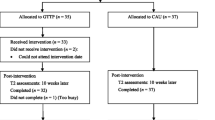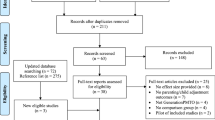Abstract
The purpose of this study is to investigate the effectiveness of a group-based family intervention program known as the Group Positive Parenting Program (Triple P), with families in Japan. Reductions in children’s behavioral problems, changes in dysfunctional parenting practices, and affects on parenting adjustment were examined. Participants of both the intervention and control groups (N = 91 and N = 24, respectively) were recruited from mothers visiting health clinics in Kawasaki City, Kanagawa. Intervention and control groups were assessed in terms of child behavior (Strength and Difficulty Questionnaire, SDQ), parenting style (Parenting Scale, PS), and parenting adjustment (Depression-Anxiety-Stress Scale, DASS; and Parenting Experience Survey, PES), both pre- and postintervention. A repeated measures multivariate analysis of variance was used to determine the intervention’s effects. The SDQ score for the conduct problems subscale indicated a significant intervention effect. In addition, the postintervention scores for all subscales of the PS, the DASS depression subscale and total scores, as well as ratings for perceived difficulty of parenting in the PES, were significantly reduced in the intervention group alone. The PES also revealed that confidence in parenting significantly increased only in the intervention group. Group Triple P is effective in decreasing child conduct problems, dysfunctional parenting practices, depression, anxiety, stress, and the perceived level of parenting difficulty, as well as in improving parenting confidence, among Japanese families.
Similar content being viewed by others
References
Arnold, D. S., O’Leary, S. G., Wolff, L. S., & Acker, M. M. (1993). The parenting scale: A measure of dysfunctional parenting in discipline situations. Psychological Assessment, 5, 137–144.
Brown, J., Cohen, P., Johnson, J. G., & Salzinger, S. (1998). A longitudinal analysis of risk factors for child maltreatment: Findings of a 17-year prospective study of officially recorded and self-reported child abuse and neglect. Child Abuse and Neglect, 22(11), 1065–1078.
Cappelleri, J. C., Eckenrode, J., & Powers, J. L. (1993). The epidemiology of child abuse: Findings from the second national incidence and prevalence study of child abuse and neglect. American Journal of Public Health, 83(11), 1622–1624.
Chaffin, M., Kelleher, K., & Hollenberg, J. (1996). Onset of physical abuse and neglect: psychiatric, substance abuse, and social risk factors from prospective community data. Child Abuse and Neglect, 20(3), 191–203.
Children’s Rainbow Center. (2009). Child abuse in Japan today, and measures for its prevention. Retrieved April 24, 2009, from http://www.crc-japan.net/english/contents/today/index.html.
Cohen, J. (1988). Statistical power analysis for the behavioral sciences (2nd ed.). Hillsdale, NJ: Erlbaum.
Dinwiddie, S. H., & Bucholz, K. K. (1993). Psychiatric diagnoses of self-reported child abusers. Child Abuse and Neglect, 17(4), 465–476.
Dubowitz, H., Black, M. M., Cox, C. E., Kerr, M. A., Litrownik, A. J., Radhakrishna, A., et al. (2001). Father involvement and children’s functioning at age 6 years: A multisite study. Child Maltreatreatment, 6(4), 300–309.
Eckenrode, J., Ganzel, B., Henderson, C. R., Jr., Smith, E., Olds, D. L., Powers, J., et al. (2000). Preventing child abuse and neglect with a program of nurse home visitation: The limiting effects of domestic violence. Journal of American Medical Association, 284(11), 1385–1391.
Eyberg, S. M., & Pincus, D. (1999). Eyberg child behaviour inventory and Sutter-Eyberg student Behaviour inventory—revised: Professional manual. Odess, FL: Psychological Assessment Resources.
Famularo, R., Fenton, T., & Kinscherff, R. (1992). Medical and developmental histories of maltreated children. Clinical Pediatrics, 31(9), 536–541.
Fujiwara, T. (2007). Population strategy to address child maltreatment in Japan. Public Health, 121, 485–486.
Fujiwara, T., Okuyama, M., & Takahashi, K. (2010). Paternal involvement in childcare and unintentional injury of young children: a population-based cohort study in Japan. International Journal of Epidemiology, 39(2), 588–597.
Fujiwara, T., Okuyama, M., Tsui, H., & Koenen, K. C. (2008). Perinatal factors associated with infant maltreatment. Clinical Medicine Insights: Pediatrics, 1, 29–36.
Goodman, R. (1997). The strengths and difficulties questionnaire: A research note. Journal of Child Psychology and Psychiatry, 38(5), 581–586.
Hahn, R. A., Bilukha, O. O., Crosby, A., Fullilove, M. T., Liberman, A., Moscicki, E. K., Snyder, S., Tuma, F., Schofield, A., Corso, P. S., & Briss, P. (2003). First reports evaluating the effectiveness of strategies for preventing violence: Early childhood home visitation. Findings from the task force on community preventive services. Morbidity and mortality weekly report: Recommendations and reports, 52(RR-14), 1–9.
Kotch, J. B., Browne, D. C., Dufort, V., & Winsor, J. (1999). Predicting child maltreatment in the first 4 years of life from characteristics assessed in the neonatal period. Child Abuse and Neglect, 23(4), 305–319.
Leung, C., Sanders, M. R., Leung, S., Mak, R., & Lau, J. (2003). An outcome evaluation of the implementation of the Triple P-positive parenting program in Hong Kong. Family Process, 42(4), 531–544.
Lovibond, S. H., & Lovibond, P. F. (1995). Manual for the depression anxiety stress scales (2nd ed.). Sydney: Psychology Foundation of Australia.
MacLeod, J., & Nelson, G. (2000). Programs for the promotion of family wellness and the prevention of child maltreatment: a meta-analytic review. Child Abuse and Neglect, 24(9), 1127–1149.
Matsuishi, T., Nagano, M., Araki, Y., Tanaka, Y., Iwasaki, M., Yamashita, Y., et al. (2008). Scale properties of the Japanese version of the strengths and difficulties questionnaire (SDQ): A study of infant and school children in community samples. Brain Development, 30(6), 410–415.
Matsumoto, Y., Sofronoff, K., & Sanders, M. R. (2007). The efficacy and acceptability of the Triple P-Positive Parenting Program with Japanese Parents. Behaviour Change, 24(4), 205–218.
Matsumoto, Y., Sofronoff, K., & Sanders, M. R. (2010). Investigation of the effectiveness and social validity of the Triple P positive parenting program in Japanese society. Journal of Family Psychology, 24(1), 87–91.
Nihon Shouni Hoken Kyokai (The Japanese Society of Child Health). (2001). Heisei 12 nendo Youji Kenkoudo Chousa Houkokusyo (Report of survey on health status of toddlers, FY2000). Tokyo: Nihon Shouni Hoken Kyokai (The Japanese Society of Child Health).
Olds, D. L., Eckenrode, J., Henderson, C. R., Jr., Kitzman, H., Powers, J., Cole, R., et al. (1997). Long-term effects of home visitation on maternal life course and child abuse and neglect. Fifteen-year follow-up of a randomized trial. Journal of American Medical Association, 278(8), 637–643.
Prinz, R. J., Sanders, M. R., Shapiro, C. J., Whitaker, D. J., & Lutzker, J. R. (2009). Population-based prevention of child maltreatment: The U.S. Triple p system population trial. Prevention Science, 10(1), 1–12.
Roberts, I., Kramer, M. S., & Suissa, S. (1996). Does home visiting prevent childhood injury? A systematic review of randomised controlled trials. British Medical Journal, 312(7022), 29–33.
Sanders, M. R. (1999). Triple P-positive parenting program: Towards an empirically validated multilevel parenting and family support strategy for the prevention of behavior and emotional problems in children. Clinical Child and Family Psychology Review, 2(2), 71–90.
Sanders, M. R., Markie-Dadds, C., Tully, L. A., & Bor, W. (2000). The triple P-positive parenting program: A comparison of enhanced, standard, and self-directed behavioral family intervention for parents of children with early onset conduct problems. Journal of Consulting and Clinical Psychology, 68(4), 624–640.
Sidebotham, P., & Heron, J. (2003). Child maltreatment in the “children of the nineties:” the role of the child. Child Abuse and Neglect, 27(3), 337–352.
Smedje, H., Broman, J. E., Hetta, J., & von Knorring, A. L. (1999). Psychometric properties of a Swedish version of the “Strengths and Difficulties Questionnaire”. European Child and Adolescent Psychiatry, 8(2), 63–70.
Turner, K. M. T., Markie-Dadds, C., & Sanders, M. R. (1997). Facilitator’s manual for group Triple P. Brisbane, Australia: Families International Publishing.
Turner, K. M., Richards, M., & Sanders, M. R. (2007). Randomised clinical trial of a group parent education programme for Australian indigenous families. Journal of Paediatrics and Child Health, 43(6), 429–437.
Turner, K. M. T., Sanders, M. R., & Markie-Dadds, C. (1999). Practitioner’s manual for primary care Triple P. Brisbane: Families International Publishing.
Windham, A. M., Rosenberg, L., Fuddy, L., McFarlane, E., Sia, C., & Duggan, A. K. (2004). Risk of mother-reported child abuse in the first 3 years of life. Child Abuse and Neglect, 28(6), 645–667.
Wu, S. S., Ma, C. X., Carter, R. L., Ariet, M., Feaver, E. A., Resnick, M. B., et al. (2004). Risk factors for infant maltreatment: a population-based study. Child Abuse and Neglect, 28(12), 1253–1264.
Yogman, M. W., Kindlon, D., & Earls, F. (1995). Father involvement and cognitive/behavioral outcomes of preterm infants. Journal of the American Academy of Child and Adolescent Psychiatry, 34(1), 58–66.
Yoshikawa, H. (1995). Long-term effects of early childhood programs on social outcomes and delinquency. The Future of Children, 5(3), 51–75.
Zelenko, M., Lock, J., Kraemer, H. C., & Steiner, H. (2000). Perinatal complications and child abuse in a poverty sample. Child Abuse and Neglect, 24(7), 939–950.
Zubrick, S. R., Ward, K. A., Silburn, S. R., Lawrence, D., Williams, A. A., Blair, E., et al. (2005). Prevention of child behavior problems through universal implementation of a group behavioral family intervention. Prevention Science, 6(4), 287–304.
Acknowledgments
This research is supported by Research on Children and Families, Health and Labor Sciences Research Grants for the program “Support Activity on Early Detection of Developmental Disorders Using the Infant–Toddler Health Checkups and Its Evaluation,” funded by the Ministry of Health, Labor, and Welfare (PI: Noriko Kato). The authors gratefully acknowledge the cooperation of Dr. Hiroko Ishidu and Dr. Mari Mashiko from Kawasaki City’s local government. We especially appreciate the mothers and children who participated in this study, without whom the study would not have been possible.
Author information
Authors and Affiliations
Corresponding author
Additional information
An erratum to this article is available at http://dx.doi.org/10.1007/s10826-015-0163-1.
Rights and permissions
About this article
Cite this article
Fujiwara, T., Kato, N. & Sanders, M.R. Effectiveness of Group Positive Parenting Program (Triple P) in Changing Child Behavior, Parenting Style, and Parental Adjustment: An Intervention Study in Japan. J Child Fam Stud 20, 804–813 (2011). https://doi.org/10.1007/s10826-011-9448-1
Published:
Issue Date:
DOI: https://doi.org/10.1007/s10826-011-9448-1




